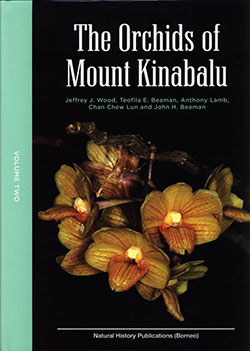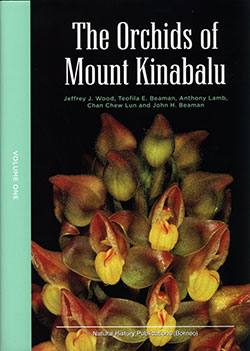The Orchids Of Mount Kinabalu
By J.J. Wood, T. E. Beaman, A. Lamb, C. Chew Lun and J. H. Beaman (2011)
1183 pages, glossy art paper, in two volumes (in a hard box case) with 845 colour photographs, 446 botanical drawings, 14 water colour illustrations and 4 maps.
Hard Cover. 28.5cm x 21cm
Volume 1 – ISBN 978-983-812-132-3: Volume 2 – ISBN 978-983-812-133-0:
Natural History Publications, Kota Kinabalu Sabah, Malaysian Borneo in Association with Royal Botanic Gardens Kew, U.K.
It is not often a new book on flora and or fauna comes along which is so good you cannot help but buy it, no matter the price! And that is exactly the category this book on the wild orchids of Sabah’s Mount Kinabalu falls into. This excellent monumental effort is without doubt one of the best (if not the best) books on orchids I have ever had the pleasure to read and or own.
Mount Kinabalu and surrounding national park, makes up an area of approximately 1250sqkm. Within this small area, it is host to an incredible 866 species of orchid in 134 genera. These numbers will surely rise, as there are large areas of Mt. Kinabalu which still remain unexplored and particularly on the northern side of this huge mountain, which rises 4095 meters into the clouds (literally). It is the highest mountain between the Himalayas and Papua New Guinea and when you drive along the road to ‘Mount Kinabalu’ it is certainly a daunting and majestic site. Numerous well known orchid species are only found here including Renanthera bella, Paphiopedilum rothschildianum and Phaius reflexipetalus to name but a few.
The first volume gives an introduction to the area with notes on conservation, scientific projects and research and with an overview of the different and diverse vegetation found here. Orchid collections from past times and present and notes and history on the original orchid collectors and their companions are mentioned (including their photographs), in particular C.E. Carr, who was the first botanist to seriously attempt to explore this massive mountain, are also covered. There are some extracts from Carr’s very detailed field diaries also reproduced taking about ‘life on the mountain’. It then goes on to notes on distribution, numbers of species and climatic correlations. Quite a large section on ecology and the different forms of vegetation and forest are covered with many orchid species examples and notes on them presented, accompanied by magnificent photographs, not just of the orchids but also the different forest types and wonderful shots of Mt. Kinabalu itself.
This volume also covers morphology and plant forms, again accompanied by many colour photos and excellent line drawings and botanical paintings. This is followed by nearly 200 pages of selected ‘noteworthy orchids’ again illustrated beautifully with many photos and botanical drawings. This volume then tappers off into pollination, systematics and phylogenetics, problematic genera etc. and keys to the genera currently known to occur here. Again, with everything beautifully illustrated. The first volume is so well constructed it is almost like being there yourself and inadvertently acts almost like a travel guide on the area.
Volume two covers all of the currently known orchid taxa from Mt. Kinabalu, including descriptions of each genus and keys to all species, with place of publication, all synonymies and studied specimens cited. Many of the species are illustrated with either or both, photographs and botanical drawings.
There are a few minor errors in this magnificent works, but being such a large production, that is not surprising. The photograph in Vol. 1 page 265, Fig 1.435 labeled Coelogyne longibulbosa with its large overlapping floral bracts, looks more like C. moultonii. The drawing of Mycaranthes oblitterata in Vol.2 page 419, does not match the photograph on page 617 Vol.2. The drawing of the labellum apex is clearly lacking the apical appendages found in that species.
A comment on page 400, Vol. 1 fig. 1.661 States, “Vanda hastifera can be distinguished from other species by the hairs on the lip”. This is not entirely correct as Vanda scandens also has hairy sides of the lip.
On page 444 Vol. 2 Stigmatodactylus Maxim. ex Makino is listed as a synonymy of Pantlingia Prain. When in fact (as pointed out by Andre Schuiteman in Malesian Orchid Journal Vol. 8: 124, 2011) Stigmatodactylus is the correct name for this genus predating Pantlingia by 5 years.
However, those things aside, which hardly detract from this books magnificence and considering it is probably the best book on orchids I have read, I cannot recommend enough you purchase this wonderful 2 volume set. It is not just applicable to Mt. Kinabalu but it is extremely useful and relevant to all South East Asian orchids in general and anyone with an interest in this area should definitely purchase this box set. Not only is this a very informative and beautifully illustrated book, but it is an investment and collector’s item.
Only 1000 copies were produced, so once they are sold, your chance to purchase a copy will be gone and I would suggest the price of this magnificent 2 volume set will increase at least 2-3 fold when that time comes. Buy it as soon as you can and I can assure you, you will not be disappointed. In Australia it is available from Andrew Isles Natural History Books in Victoria (books@andrewisles.com) and Orchidaceous Books in Queensland (books@orchidaceousbooks.com.au). Or alternatively, you could contact the publisher ‘Natural History Publications’ direct on their email at; info@nhpborneo.com
Rod Rice
Principal Reviewer & Scientific Advisor
Nature & Travel Books


